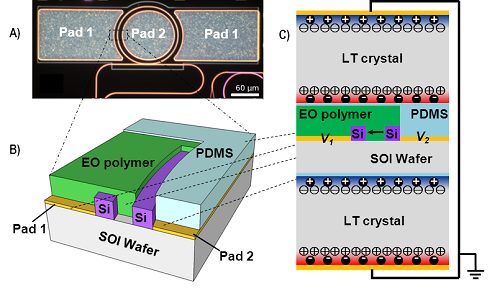
Pyroelectric poling of EO polymers in hybrid E-O polymer silicon slot waveguide ring-resonator modulators.
Electro-optical polymers can be efficiently poled with a static field generated by pyroelectric crystals, report Alex K.-Y. Jen and co-workers at the University of Washington. The research appears in the first issue of Advanced Optical Materials.
Dipolar chromophores in electro-optical polymers are normally poled (aligned) using external voltage sources. A polymer can be placed in direct contact with a metal electrode (contact poling), or positioned in a corona discharge (corona poling). However, these techniques can result in dielectric breakdown or surface damage to the films.
In contrast, pyroelectric materials develop surface charges and generate high electric fields in response to changes in temperature. Jen and co-workers use lithium niobate (LiNbO3) and lithium tantalate (LiTaO3) crystals to generate orientational polarization of a dipolar phenyltetraene chromophore in poly(methyl methacrylate).
Using this approach, the authors obtained a very large Pockels coefficient of 81 pm/V. This is ~90% of the highest value achieved by the conventional contact or corona poling methods.
In addition, the resonance wavelength shift (25 pm/V) in hybrid polymer silicon slot waveguide ring-resonator modulators can be tuned. The effective fields in these experiments were estimated to be around 0.5 to 0.9 MV/cm. An electrostatics analysis performed with an idealized model correlates well with this experimental result.
According to the authors, “These results are expected to contribute significantly to the development of fundamental understanding of electrostatics, particularly of pyroelectrics, electro-optical polymers and hybrid polar dielectric systems, and to the exploration of new concepts for the fabrication of photonic devices.”
The paper, “Efficient Poling of Electro-Optic Polymers in Thin Films and Silicon Slot Waveguides by Detachable Pyroelectric Crystals“, is available for free download from Advanced Optical Materials.

















